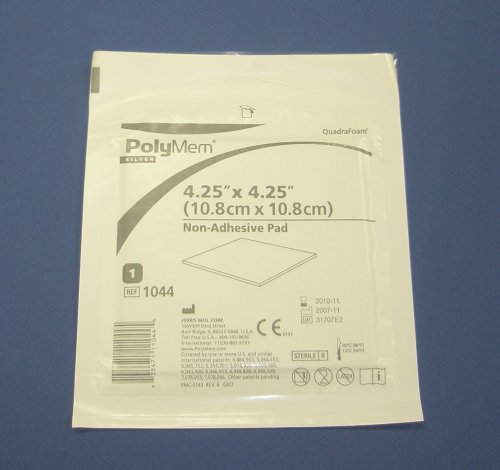
| Product Name: | Polymem Max |
| Classification Name: | Hydrophilic polyurethane foam with surfactant, humectant and superabsorbent |
| Manufacturer: | Aspen Medical Europe |

PolyMem Max dressing consists of a hydrophilic pink polyurethane foam sheet about 5 mm thick bonded to a semipermeable polyurethane film.
The porous foamcontains a non-ionic surfactant which is activated by moisture and claimed to facilitate wound cleansing, together with a humectant (glycerol) which prevents the dressing drying out and adhering to the wound bed, and a starch copolymer to enhance the fluid handling properties of the foam.
The transparent, gas and moisture vapour permeable backing layer provides a barrier to liquid thereby preventing strikethrough and reducing the risk of bacterial contamination of the dressing or the local environment.
In addition to providing means of fixation, the transparent, gas and moisture vapour semipermeable backing layer provides a barrier to liquid thereby preventing strikethrough and reducing the risk of bacterial contamination of the dressing or the local environment.
PolyMem Max dressing may be used in the treatment of moderate to heavily exuding leg ulcers, diabetic ulcers, pressure areas, donor sites, first and second degree burns and other superficial granulating lesions. It may also be used as an alternative to standard PolyMem in the treatment of more lightly exuding wounds when longer wear times are required.
Although there are no known contra-indications to the use of PolyMem Max, the dressing should not be used on individuals who are known to be sensitive to any of its components.
A suitably sized dressing should be selected which ideally overlaps the wound margin by 1-2 cm in all directions. Once the wound has been cleansed or prepared in accordance with local protocols, the dressing is applied with the film layer facing outwards and held in place with surgical tape or a bandage as appropriate. Absorbent secondary dressings are not generally required or indicated. If necessary the dressing may be cut or shaped for application to awkward or hard to dress anatomical sites. In many instances, the combined actions of the dressing components are claimed to eliminate the necessity of further wound cleansing during subsequent dressing changes.
The interval between dressing changes will depend entirely upon the state of the wound and the amount of exudate produced. As a general rule a dressing change should be considered when exudate, visible through the top of the dressing, extends past the periwound margin. If wound fluid reaches the edge of the dressing pad the dressing should be changed immediately.
On a lightly exuding wound in an otherwise healthy patient, the dressing may remain in place for up to 7 days but as with other products more frequent changes may be indicated if the patient has a compromised immune system, diabetes, or infection at the wound site. In some instances, exudate production may appear to increase during the first few days of treatment due to the pronounced hydrophilic nature of the absorbent layer and the dressing may need replacing daily, but as healing progresses and exudate production diminishes, the interval between changes may be extended.
For wounds that develop signs of clinical infection, a change to a dressing with antimicrobial properties such as PolyMem Silver should be considered, and systemic antimicrobial therapy initiated where appropriate.
The dressings are presented individually packed in peel pouches, sterilised by radiation.
PolyMem Max is available in a range of sizes as follows;
Further information on obtaining
Aspen Medical Europe
products is available on the
Aspen Medical Europe
web site.
| Revision Author | Dr S. Thomas |
| Revision No | 1.5 |
| Revision date | 2009/04/15 |
This datacard has been prepared from data provided by the manufacturer and/or from published literature.